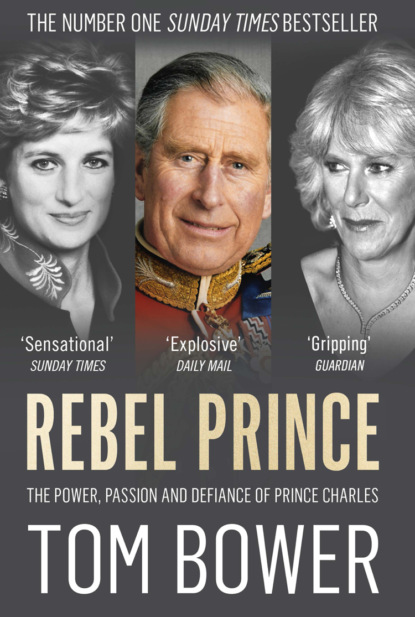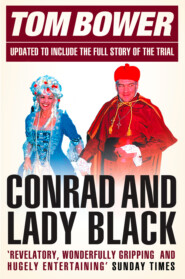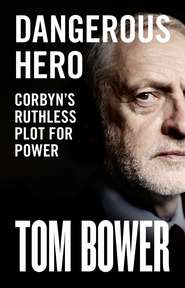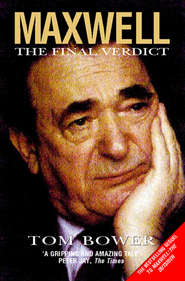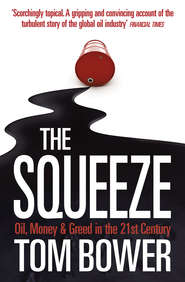По всем вопросам обращайтесь на: info@litportal.ru
(©) 2003-2024.
✖
Rebel Prince: The Power, Passion and Defiance of Prince Charles – the explosive biography, as seen in the Daily Mail
Настройки чтения
Размер шрифта
Высота строк
Поля
The tension led to disagreement between Charles and his four horsemen Bolland, Kent, Brown and Bessent. Their confidence in the value of publicity had been eroded.
‘It wasn’t the right time,’ concluded Higdon. ‘It didn’t feel right for Camilla. It was too soon.’ She was ‘not great’ with Americans. Even worse, she was lazy. ‘For her to get up in the morning and survive until nightfall is a major effort. It was even hard for her to get out of bed. She tries her best to do nothing during the day.’ On the American trip, ‘the biggest problem was persuading her to dress up for a big occasion. The effort was overwhelming. Camilla was pissed off by the whole thing. It was horrible, a disaster.’
While Camilla argued on the phone, Peter Brown was fretting in Brooke Astor’s luxurious Park Avenue apartment. The guest of honour was already thirty minutes late. ‘She’s gossiping with you-know-who,’ Brown confided to one of the guests, unaware of the true circumstances. But when Camilla did finally arrive, no sign of any argument was visible. That skill offset her limitations, and was adored by Charles.
On public occasions she did her best to shine. Three days before flying to New York she had appeared to enjoy a dinner for fifty guests in the Chelsea home of the Greek shipping and steel magnate Theodore Angelopoulos and his wife Gianna, and a few days earlier she had been jolly at Geoffrey Kent’s fifty-sixth birthday party, despite her intense dislike of two of her fellow guests, Hugh and Emilie van Cutsem, both close friends of Charles.
In her unusual world, Camilla was happier when having dinner later that night at Harry’s Bar with Andrew Parker Bowles, her former husband, and his new wife. Andrew was one of the few among her associates who aroused no antagonism among the courtiers. Others, she discovered, were less fortunate in the vicious intrigues around the court.
A new plot, allegedly inspired by Galen Weston, a Canadian billionaire, had sought to oust Geoffrey Kent from Charles’s inner circle. Weston was irritated that Charles played for Kent’s polo team, and that Kent, rather than Weston, was the team captain. Their rivalry had spilled out into a dispute about a joint property development near Palm Beach. Now Weston was seeking to persuade Charles to dump an ally. Venomous spats among courtiers were not unusual for Charles. Despite the generosity shown to him by Kent, a global networker, Charles rarely reciprocated loyalty. ‘We don’t have close friends,’ he had told a member of the polo team. ‘The royal family does not allow anyone to become too familiar and be privy to our secrets.’
During a helicopter trip – a moment chosen so the police escort could not overhear – Bolland had spoken to the prince about his benefactor’s fate. ‘He’s been a good and generous friend,’ agreed Charles. ‘Tell Stephen not to do anything. I’ve changed my mind.’ Stephen Lamport, Charles’s senior private secretary and Bolland’s superior, was accustomed to cutting off those who had displeased his master, and readmitting those who were pardoned.
Charles’s decisions were often influenced by money, and in recent years Camilla had adopted the same criterion. The previous month, she and Charles, her two children and over twenty friends had sailed around the Aegean on the Alexander, the world’s third largest private yacht. They were the guests of Yiannis Latsis, a foul-mouthed Greek shipping billionaire whose fortune, some gossiped, was based on black marketeering, collaboration with the Nazis, and bribing Arabs for a stake in the oil trade. Six weeks later, after her introduction to Edmond and Lily Safra in New York, Camilla discovered that the billionaire banker also owned a luxury yacht, as well as an eighteen-acre estate in the south of France, La Leopolda, valued at over $750 million.
‘Is there any chance,’ Camilla had asked Higdon, who had made the introduction, ‘that I could stay at Lily Safra’s?’ An invitation to visit St James’s Palace was duly issued to Safra, and soon afterwards Michael Fawcett was arranging Camilla’s holiday on the estate.
Her current trip to New York was part of Charles’s campaign to win over the British people; but in 1999 that struggle was far from won.
2
Plots and Counterplots (#u12485211-0c5e-5d96-9fec-52bcfd604665)
Charles’s campaign to make Camilla accepted had started in 1996, one year before Diana’s death, a period that marked a new peak in the public’s disgust with the lives in the royal palaces. A succession of scandalous books, tapes and television interviews had reduced the prince’s approval rating to less than 10 per cent. Fearful that he would not inherit the crown, and even worse, that he might buckle under the pressure, Camilla had discussed his plight with Hilary Browne-Wilkinson, the solicitor who had managed her divorce from Andrew Parker Bowles. Soon after, Charles and Camilla invited Hilary and her husband, Nicolas ‘Nico’ Browne-Wilkinson, a senior judge, for dinner at St James’s Palace. The third guest was Fiona Shackleton, Charles’s divorce lawyer, at that time a decisive influence in his life.
‘You must deal with your media image,’ Nico Browne-Wilkinson told Charles.
Nico’s wife offered a solution. While working at the Press Complaints Commission she had met Mark Bolland, the Commission’s twenty-nine-year-old director and in his private life the partner of Guy Black, a Cambridge graduate and political adviser. Bolland, Hilary Browne-Wilkinson said, was charming and well-connected, and had good relations with London’s senior media executives. He was also an outsider. Unlike other palace officials, he had been educated at a grammar school in Middlesbrough and had gone neither to Oxbridge nor the army, but had read Chemistry at York University. His understanding of the real world made him an ideal choice to promote Camilla and secure the public’s acceptance of her relationship with Charles. Hilary was supported by Fiona Shackleton, who said Bolland should be appointed as soon as Charles’s divorce was finalised.
By the end of the evening, Charles and Camilla were half-persuaded. Both Shackleton and Hilary Browne-Wilkinson appeared relieved. Dabbling in that world, with access to the heir to the throne, was a fizzy experience for both lawyers. Charles’s reliance on such people signalled his anguish. In 1996 he was searching for scapegoats to blame for a decade of horror. Prone to grasp at any excuse, he agreed with the latest judgement of his inner circle of friends that Richard Aylard, his private secretary, was mainly responsible for his plight.
In their opinion, Aylard’s cardinal error had been to encourage Charles two years earlier to open his heart to the journalist Jonathan Dimbleby for a biography and a two-hour television documentary.
Over the previous months Aylard had spent nearly every day and many nights responding to his employer’s cries for protection from criticism, sacrificing his own private life and his marriage. To overcome Charles’s bouts of depression, he had encouraged him to cooperate with Dimbleby. When the resulting book and film proved a personal disaster, Charles refused to accept any blame for pressing Aylard to arrange the extraordinary access to his secrets.
The Dimbleby project had been born from Charles’s anger that he was being treated as a mere ribbon-cutter rather than as the heir to the throne. His status had been devalued among courtiers in Buckingham Palace and some cabinet ministers by his refusal to end his relationship with Camilla. At that time, the very notion that the couple might marry was ridiculed by a country that had lost respect for the man who had betrayed his wife Diana. Unless Camilla was ousted, the critics agreed, Charles could not remain the queen’s automatic successor. Inaction might even jeopardise the monarchy itself. The huge majority of the public reflected the homily of Walter Bagehot, Britain’s nineteenth-century constitutional expert: ‘We have come to regard the monarchy as the head of our morality.’ Charles failed that test.
His fate had been dictated by a series of humiliations, not least by Diana’s disclosures in Andrew Morton’s 1992 book Diana: Her True Story. Morton’s revelations had broken through the carapace of lies about the royal marriage. Diana had portrayed her estranged husband as an unloving and unfaithful father without a care for anyone except himself. ‘It is so very awful,’ Charles wrote to Nancy Reagan, the former president’s wife; ‘very few people would believe it.’ Through Dimbleby, Charles wanted to right the balance but also to retaliate, to have his revenge against a wrecker.
First he agreed to the queen’s insistence that he and Diana formally separate. The announcement was to be made by John Major, recently re-elected as prime minister.
A strong prime minister would not have tolerated the warfare between Charles and Diana, and would have halted the books and briefings. Instead, Major believed that his duty was to reconcile the two and restore the public’s trust. Sympathetic to Diana’s side of the case, he did not underestimate his task, particularly after a private flight when Diana had emerged from the plane’s lavatory covered in blood. There was no explanation other than that she was psychologically unwell.
Major’s intentions were obstructed by Buckingham Palace. Robert Fellowes, the queen’s private secretary, gave no clear guidance about the royal family’s attitude. Until the circumstances were compelling, Fellowes judged, the queen would remain reluctant to interfere. Her inactivity magnified the ineptitude of her advisers. ‘The trouble is that Charles is a Hanoverian,’ a senior civil servant observed, ‘and now that he’s delivered “an heir and a spare” and has done his duty to the nation, he thinks he’s entitled to live the way he wants.’ In the coded language of the official classes, he added, while Diana Spencer could trace her family’s British ancestors back to 1478, the Windsors had been invented only in 1917. Their history became irrelevant when the queen’s hand was finally forced by Diana’s secret cooperation with Morton and her untruthful denials of that pact to Fellowes.
At Charles’s request, Aylard had insisted to Major that when announcing the formal separation he should tell the House of Commons that ‘no third party’ was involved; and so on 9 December 1992 the lie was formally announced in a speech drafted by a quartet of officials: cabinet secretary Robin Butler, Robert Fellowes, Buckingham Palace’s senior spokesman Charles Anson, and Aylard.
To control the narrative, Charles expected Aylard to dictate the ‘truth’ about the separation, a divorce and the possibility of remarriage by employing the usual convenient formulas: ‘There are no plans …’ or ‘It is not the intention that …’ Silence and denial were his tactics to become king – a contested succession, as some senior bishops doubted whether an adulterer could lead the Church of England.
Aylard knew that loyalty meant suspending the conventional role of a private secretary. Unlike the queen’s supportive working relationship with Fellowes, Charles would not tolerate Aylard discussing whether muddying the facts about his relationship with Camilla was tolerable. To continue as Charles’s adviser required acceptance that the heir was infallible, divinely ordained, and that his ‘truth’ remained unchallenged. That fiction had been instilled in Charles since childhood. Reminded of the fate of Europe’s other royal families, he had learned that the House of Windsor’s survival depended upon minimising the public’s indifference, assuaging its hostility and dispelling any suggestion of insecurity.
To fulfil that ambition, Robin Butler had included in Major’s statement a second fiction. Despite their legal separation, Major would tell MPs, there were no constitutional implications; with a formal separation rather than a divorce, on Charles’s accession Diana would still be queen. Butler would later concede that his advice was wrong.
Early on the morning of his announcement, the prime minister shuttled between Diana in Kensington Palace and Charles in St James’s Palace to seal their final approval. Any satisfaction he may have felt was shredded a few hours later when his statement in the House evoked widespread derision. His suggestion of a monarchy of two separate individuals offended the British reverence for their royal family. Instead of calming the public, the speech raised speculation that Charles might abdicate.
The queen had already responded to the danger: persuaded that she had to reprimand her son, she had forbidden him to move from Kensington Palace into Clarence House, the queen mother’s home, after formally separating from Diana. The prospect of Charles entertaining Camilla in a palace shared with his grandmother, then aged ninety-two, was offensive. He had been assigned instead to St James’s Palace, a cold, comfortless dwelling.
At which point, his troubles increased. Five weeks later the Daily Mirror published the transcript of an eight-minute telephone conversation between Charles and his mistress. Millions around the globe listened as he told Camilla how he yearned to ‘live inside your trousers’ and be reincarnated as ‘God forbid, a Tampax, just my luck … to be chucked down the lavatory and go on and on forever swirling round the top, never going down’. Charles fled to Sandringham, hoping never to see a newspaper again. He was, however, unable to escape a Daily Telegraph report that his approval rating had fallen to 4 per cent. Further crises seemed imminent. He lacked even the authority to demand an investigation into who had targeted him. The obvious suspect was a rogue employee at the government’s intercept agency GCHQ who had recycled his work to amateur radio hams.
‘You have to be careful which shadows you decide to chase,’ Diana told Patrick Jephson, her private secretary, to explain why no proper inquiry had been demanded. Like Charles, she suspected that her police protection officers leaked her and Charles’s secrets, especially their adulteries. The police had accumulated considerable influence over the royals, not least after Diana and Princess Anne had affairs with their protection officers. Unethically, other officers had used that information to cultivate lucrative relationships with the media.
Charles stopped talking to journalists in 1993, even during foreign trips. Damaged by the recent revelations, he now repeatedly complained about the lack of safeguards. A senior Downing Street official was summoned to St James’s Palace and asked to ban photographers from around Balmoral, the queen’s fifty-thousand-acre estate in north-east Scotland. ‘There’s not much we can do if you go near the public highway,’ Charles was told. ‘You’ll just have to find somewhere on the estate which they can’t see, even if it’s less attractive.’
That exchange jarred after the news emerged about Charles’s negotiations over an authorised film and biography. Jonathan Dimbleby was the younger son of Richard Dimbleby, the hugely respected BBC journalist and the nation’s trusted commentator on all state occasions until his death in 1965. That pedigree was ignored beyond St James’s Palace. Speaking on behalf of the senior officials in Buckingham Palace, Robert Fellowes had strongly advised Aylard to resist Dimbleby’s offer. After Charles made his enthusiasm plain, the queen was advised to intercede. As usual, she replied that Prince Philip should be asked for his opinion; together they decided not to interfere.
Their reluctance stemmed from the breakdown in relations with their son. Charles had publicly blamed his parents, particularly Philip, for an unloving childhood and being forced into an unhappy marriage. In graphic terms, he saw his father as an emotional gangster. He wanted to appeal through Dimbleby for the public’s sympathy. To present Charles’s point of view, Dimbleby was given unprecedented access to his private papers, his friends and employees, and extensive interviews with Charles himself.
Controversy, the prince knew, was inevitable. While reading the proofs of Dimbleby’s book during a trip on the royal yacht Britannia, he regularly shouted his protests to Aylard, who in turn negotiated changes with Dimbleby – who, as he sympathised with Charles’s predicament, was usually receptive. But no one ever sought to stop publication. The result was a remarkably intimate but ultimately destructive profile.
Dimbleby presented a portrait of a vulnerable, friendless forty-six-year-old, still bearing the scars of his harsh school years at Gordonstoun. In the journalist’s graphic description, Charles never understood close companionship between schoolboys or the mutual reliance that existed among friends. Immune to the social revolution of the sixties, he resented his peers for not appreciating or understanding him.
At Cambridge he remained ‘the prince’, denying himself any relationship between equals. Nurtured to believe in his superiority, he became intolerant of criticism and refused to accept blame. Speaking to Dimbleby may have provided some therapy to relieve his demons, but by exposing his limited self-confidence he showed himself as self-destructive, thin-skinned and over-eager to find fault with others, especially his parents.
As a young man, Charles had craved a spiritual guide. He found one in Laurens van der Post, the South African explorer, writer and somewhat eccentric philosopher. Employing mystical terms, van der Post offered the young Charles a voyage of self-discovery and a comfortable port by telling him that, despite his possibly limited time as king, he could prove his greatness as Prince of Wales. Inspired by van der Post’s lectures about African tribesmen, environmental pollution and the benefits of complementary medicine, Charles developed a ragbag of beliefs linking mysticism, divine powers, geometric measurements, orthodox Christianity and Islam.
Dimbleby’s book revealed other impolitic principles. Previously, the public had been unaware that the heir to the throne was not a conventional Anglican. One single sentence threatened centuries of British stability. As monarch, Charles told Dimbleby, he would prefer to be ‘defender of faith rather than of The Faith’. The Church of England and constitutional experts alike were disturbed by his doubt about swearing the traditional coronation oath to protect the Protestant settlement of 1701. There were now not one but two religious objections to Charles succeeding.
In Dimbleby’s television documentary, the aspiring king pleaded for understanding. ‘It’s not a holiday, you know,’ he said to camera. ‘It’s all so difficult … I can’t describe the horror of seeing your life set in concrete.’ Instead of offering himself as a visionary leader, he came across as a picture of harassed weakness. As he rambled on, with a series of eye-rolling expressions, grimaces and scowls, his audience was left perplexed. ‘Who are you?’ he was asked by a child in the documentary. ‘I wish I could remember,’ he had replied.
In preparation for the programme, uppermost in the TV producers’ thoughts had been ‘the Camilla question’. The relationship had never been officially confirmed. After some discussion, Charles believed that a confession would ‘clear the decks’. Dimbleby’s enquiry about his marriage was straightforward: ‘You were, because of your relationship with Camilla Parker Bowles, from the beginning persistently unfaithful to your wife and this caused the breakdown?’ Instead of briefly expressing his regret, Charles replied, ‘I was faithful until it was clear to me that my marriage had irretrievably broken down.’ He then admitted his adultery, denied that he was considering divorce, and insisted he would be king. Royalist newspapers proclaimed that Charles had ‘willingly cooperated in [his] own destruction’. The Sunday Times headline for its serialisation of Dimbleby’s book summarised its central message: ‘Charles: My Agony’.
The public was aghast. Soon after publication he made a ceremonial return to Caernarvon, where twenty-five years earlier a global TV audience had watched his investiture as Prince of Wales. Just days after his televised confession, Charles drove through the town’s empty streets; local television did not interrupt its coverage of racing from Sandown Park.
In hindsight, Dimbleby’s highlighting the facts about Charles’s marriage had in one way been a blessing, forcing the pace for his divorce. But while Charles may have settled the score, he had prepared the way for far-reaching repercussions that he could never have anticipated.
The battle with Diana had revealed the woeful mismanagement of the royal family by the queen as well as by Charles’s senior advisers. The prince’s relationships with his private secretaries had always been fractious. Aylard, appointed in 1992, was his fourth in seven years. Edward Adeane had resigned in 1985 after a row about Charles’s uncontrollable love of controversy; John Riddell, a genial businessman who was appointed in 1985, laughed about the chicanery of courtiers and cursed the shambles of Charles’s lifestyle. ‘Every time I made the office work,’ Riddell observed, ‘the prince fucks it up again. He comes in, complains that his office is “useless” and people cannot spell and the world is so unfair, and then says, “This is part of the intolerable burden I put up with. This incompetence!”’ Such outbursts manifested the prince’s intolerance rather than a desire for perfection. After Riddell resigned five years into the job, Charles refused to award him the customary knighthood, an omission later rectified by the queen. ‘Charles would be fantastic as a second-hand-car salesman,’ Riddell told a colleague. ‘He has the right enthusiasm and conviction to sell. Then you remember he’s heir to the throne.’
Riddell’s successor was Major General Christopher Airy, the former commander of the army’s London District. Airy was hired only after being vetted, at Charles’s request, by Jimmy Savile. The TV personality, dressed in a silver tracksuit and sporting gold bangles, had met the candidate in Kensington Palace. ‘My job,’ explained Savile, ‘is to persuade you not to take the job. That’s what Prince Charles has asked me to do.’ Airy was bewildered. How, he wondered, had Savile – posthumously exposed as a serial predatory paedophile – induced the royals to allow him to make unannounced visits to Kensington Palace and be invited to Charles’s fortieth birthday party? The prince had even sent Savile a box of Havana cigars – a gift from Fidel Castro – with a note: ‘Nobody will ever know what you’ve done for this country, Jimmy. This is to go some way in thanking you.’ On his second interview, Airy was told by Savile that his appointment had been approved – but to expect lengthy waits whenever summoned by Charles.
The prince’s misjudgement about Savile coincided with his sympathy towards another sexual offender. He allowed Peter Ball, the Bishop of Lewes and Gloucester, to live in a property in Somerset provided by the Duchy of Cornwall despite the prelate’s admission that he had abused boys. The police, documents would later reveal, had cooperated with leaders of the Church of England, particularly George Carey, the Archbishop of Canterbury, to ‘prevent a scandal’, partly because Ball was ‘friendly with Prince Charles’. ‘I wish I could do more,’ Charles wrote to the paedophile in 1995, angry that Ball had not been re-appointed as bishop. ‘I feel so desperately strongly about the monstrous wrongs that have been done to you and the way you’ve been treated.’ Ball would be jailed in 2015.
These shameless relationships were unfamiliar to Airy. Within a year of his appointment, the ceremonial guardsman was reprimanded for suggesting to Charles that a forthcoming and unwelcome visit was ‘your duty, sir’.
‘Duty is what you do!’ Charles shouted at him. ‘Duty is what I live – an intolerable burden.’
Soon after, unaccustomed to his employer’s campaigns about poverty and his propensity for flying to hot climates for environmental summits, Airy was summarily fired – knifed, some speculated, by Aylard, his successor. Airy’s misery on his dismissal was later rekindled by gratuitously unpleasant comments about him in Jonathan Dimbleby’s book. Charles was a bad enemy. He carried grudges. That was the background to his disillusionment with Aylard. The fallout from the Dimbleby project exposed Aylard as hidebound by court procedure and unable to think outside the box. His lack of sympathy for new ideas increased the temptation for Charles to recruit Mark Bolland. He needed a saviour to relieve the agony of the previous fifteen years.
Ever since 1981, when a billion people around the world had watched his marriage to Diana, the battle of the Waleses had aroused global fascination. The accepted story of a selfish and cruel older man betraying a beloved icon was, Charles believed, the product of mismanagement by his advisers, although Charles conceded that even the best spin doctors would have been overwhelmed by the revelations about his private life.





